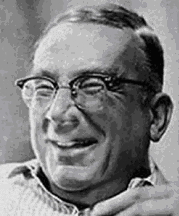Astronomy Bio...George Gamow
Jay Bitterman
Georgi Antonovich Gamow was born in 1904, in Odessa, Russia. A fascination with astronomy blossomed early and his father presented him with a telescope on his thirteenth birthday. He started to systematically study the stars and at this point decided to become a scientist.
At the age of 18 he entered Novorossia University. From 1923-1929 he took courses in optics and cosmology at the University of Leningrad. In the summer of 1926 he attended school in Göttingen in Germany. During his research he solved the answers to the phenomenon of natural radioactivity and developed his quantum theory of radioactivity. It was the first successful explanation of the behavior of radioactive elements, some of which decay in seconds, while it takes others thousands of years to decay. He received his PhD degree from the University of Leningrad in 1928.
 In 1929 George went to Copenhagen and told Niels Bohr of his studies. Bohr became very interested in his work and offered him a one-year scholarship at the Royal Danish Academy to study at the Institute of Theoretical Physics. Gamow proposed the hypothesis that the atomic nuclei could be treated as little droplets of "nuclear fluid". This discovery resulted in today's theory of fusion and fission.
In 1929 George went to Copenhagen and told Niels Bohr of his studies. Bohr became very interested in his work and offered him a one-year scholarship at the Royal Danish Academy to study at the Institute of Theoretical Physics. Gamow proposed the hypothesis that the atomic nuclei could be treated as little droplets of "nuclear fluid". This discovery resulted in today's theory of fusion and fission.
From 1929 to 1930 he co-operated with F. Noutermans and R. Atkinson as a Rockefeller Fellow, Cambridge University, in an attempt to apply his formula to calculate the rate of induced nuclear transformation (thermonuclear reaction) within the interior of the stars. This formula has successfully been used to design Hydrogen bombs, and in studies of the probability to control thermonuclear (fusion) reactions.
In 1931 Gamow was summoned to return to the Soviet Union to become Master of Research at the Academy of Science in Leningrad. Also, in 1930, he married Luybov Vokhminzeva, eventually divorced in 1956. In 1935 Gamow's son Rustem Igor was born.
In 1933 the Soviet government permitted Gamow and his wife to attend the Solvay Congress in Brussels. By allowing Luybov to go along as Gamow's secretary, they realized their chance to escape to the west. They had difficulty in obtaining visas in Solvay, so instead of remaining there, they visited the Institute de Pierre Curie 1933-1934. Concurrently, Gamow was a visiting professor at the University of London. In 1934, while in Europe, Gamow received an invitation from the University of Michigan to give a lecture. So, rather than returning to the Soviet Union or remaining in Europe Gamow and his wife went to America. Eventually he was offered the Chair of Physics at George Washington University, where he taught from 1934 to 1956. During the Second World War Gamow was involved in developing of the atomic bomb in the Manhattan project and he contributed to the research at Los Alamos, which ultimately led to the making of the Hydrogen bomb.
Gamow's main astronomical research concerned the origin of the universe and the evolution of stars. As a starting point for his own research, Gamow adopted Hans Bethe's model of stars. It stated that heat and radiation is generated in the cores of stars (thermonuclear reactions), and therefore a star heats up, rather than cooling down as fuel is consumed. Gamow's most famous contribution to astronomy was his research and theories that supported Abbé Georges Lemaître's Big Bang Theory of the expanding universe.
In addition, Gamow was well known as an author of popular scientific books. Many people enjoyed such stories as "Tompkins in Wonderland" to explain the general theory of relativity.
Gamow collaborated with Edward Teller on the theory of beta-decay, a nuclear process in which an electron is emitted; this led to the "Gamow-Teller selection rule for beta-emission". In 1942, using his knowledge of nuclear reactions to interpret stellar evolution, he collaborated with Teller on a theory of the internal structure of red giants. As a result, Gamow postulated that the Sun's energy results from thermonuclear process.
During his later years he was involved with research in biology that resulted in the solving of the mystery of the DNA-coding system. In 1954 he was the first to propose that nucleotide groups in the living cell had coded information for the construction of proteins.
In 1956 UNESCO awarded Gamow the Kalinga prize for popularizing science. Gamow married Barbara Perkins, his publisher from Viking press, in 1958. In 1956 Gamow became a professor of physics at the University of Colorado. In 1965 he became an Overseas Fellow of Churchill College at Cambridge University. On August 19, 1968, he died in Boulder Colorado of liver failure. Before his death he said that "Finally my liver is presenting the bill", which characterized his life of carefree eating and drinking. After his death the department of physics and Mrs. Barbara Gamow established the George Gamow Memorial Lectures. The George Gamow Tower of the University's Duane Physical Laboratories building was named in his honor.
Published in the March 2003 issue of the NightTimes




